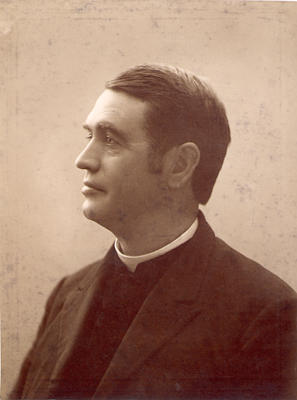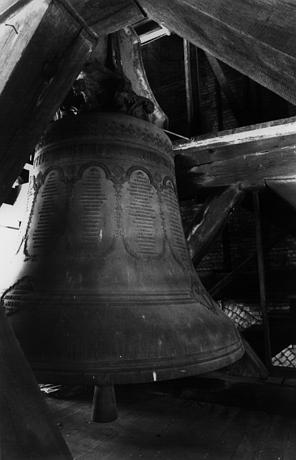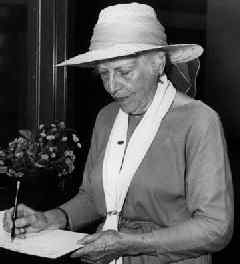
Notre Dame's Grotto / by Dorothy V. Corson

Father Corby's Promise
Excerpts from the June Annals , described Father Corby's promise to build a Grotto at Notre Dame:
Grotto of Lourdes at Notre Dame, Indiana
. . . About a year and a half ago our Provincial, Father Corby, desired a great favor for the benefit of his Community in the United States. He started at once for Europe, and after attending to some important business in Rome, directed his steps to Our Lady of Lourdes, France, where he celebrated Holy Mass, said some fervent prayers, and then placed his desired request in the blessed hands of Our Lady of Lourdes. Then and there he promised, with God's help and the help of friends of Mary, to build at Notre Dame a Grotto in honor of the Immaculate Conception, if Mary would grant him his request. On the first day of May, 1895, -- Mary's own Month -- he was informed by cable that his request was granted. This convinced him that the favor was obtained by the Immaculate Lady of Lourdes. During the whole year after, he had in mind the promise he had made to the Blessed Virgin, but a combination of circumstances prevented him from fulfilling his promise. He resolved, however, to begin the work this Spring, and late in April, 1896, he wrote a friend in the East to help him build the Grotto. Strange to say, this friend responded promptly with a handsome donation, and it came on the Eve of the first day of May, just as the exercises of the Month of May were about to commence. This he looked on as an additional proof of Mary's gracious and maternal kindness. Moreover, it seemed to be a sanction on her part of all that had been done. First, the spiritual favor was announced as granted on the first of May; and second, the first generous donation for the building of the Grotto came on the first of May. This is to say then on her part, "You asked a favor of me and I granted it. Now, I will help you to fulfill your promise, to build me a Grotto, and I send you on the first of May, -- my own month -- money to enable you to begin at once." Mary, evidently, from what we have experienced, wants a Grotto at Notre Dame. This we see from the simple facts mentioned above. When in France, at Lourdes, Father Corby was presented, by the Superior of Lourdes, a model of the Grotto made of metal to build by. He also brought with him the exact dimensions of the Grotto at Lourdes, and he intends to reproduce at Notre Dame, a fac- simile , the exact size of the original. . . . The work on the foundation of the Grotto has commenced, and we hope to see it finished by the 15th of August next -- feast of the Assumption.(123)
 The friend who responded to Father Wm. Corby's appeal for help in financing the Grotto was Rev. Thomas Carroll. His letter to Father Corby, on April 28, 1896, is preserved in Father Wm. Corby's correspondence in the archives of the Holy Cross Order at the Indiana Province Archives Center. It confirmed that Father Carroll paid all the Grotto costs, about $2,500. Carroll left this proviso to Father Corby in that letter:
The friend who responded to Father Wm. Corby's appeal for help in financing the Grotto was Rev. Thomas Carroll. His letter to Father Corby, on April 28, 1896, is preserved in Father Wm. Corby's correspondence in the archives of the Holy Cross Order at the Indiana Province Archives Center. It confirmed that Father Carroll paid all the Grotto costs, about $2,500. Carroll left this proviso to Father Corby in that letter:
. . . provided you on your part, carry out all that you promise. As you say, I may end my days at Notre Dame under the shadow of the grotto. Favor I wish inscribed on the marble slab, that the blessed Mary, Our Lady of Lourdes may obtain for me the Grace of a happy death.
Father Wm. Corby acknowledged Father Carroll's generous gift with these prophetic words of appreciation:
. . . You will have made many good investments; but likely this [is] the best you ever made. With the prayers of the community and the maternal care of Mary, you, I hope will be richly rewarded in time and in eternity.(124)
Although Rev. Thomas Carroll's marble donor plaque is weathered and worn now, those words are still discernible on it. An 1896 article written after the Grotto was completed tells more about the man who financed it.
Rev. Thomas Carroll of Oil City, Pa., was a student here in 1855. He was ordained in 1859. His name, to those at Notre Dame who have never met him, has come before him, for it is inseparably linked with the history of our beautiful "Grotto of Lourdes," which his beneficence made possible.
Father Carroll has been an indefatigable builder. To him is due the honor of erecting one of the 1st Catholic churches and presbyteries ever reared in South Bend -- old St. Patrick's. To this man's generosity Notre Dame owes one of her most beautiful, most faith-inspiring scenes, a shrine to which not only we at Notre Dame, but others from outside, carry burdens and go away relieved.(125)
When the site for the new Grotto was chosen in 1896, it had already been hallowed by memories:
Just behind the presbytery is a little wooded dell which has always been regarded as one of the charming spots at Notre Dame. For years the pilgrims from Kalamazoo and Jackson have chosen it as a resting place after their long journey; it has been a favorite walk with visitors at all times; and during the spring and autumn those who live at Notre Dame seek it instinctively for its coolness and attractiveness. It is where the Grotto has been built.(126)
 A good many families in town were related, in one way or another, to one common ancestor -- Louis Hickey -- who was also linked to Notre Dame. His obituary in the Scholastic carried this mention of his many years of service to Notre Dame:
A good many families in town were related, in one way or another, to one common ancestor -- Louis Hickey -- who was also linked to Notre Dame. His obituary in the Scholastic carried this mention of his many years of service to Notre Dame:
He was an intimate friend of Father Sorin and his life was closely connected with the University. He cut the first road from Notre Dame to South Bend and spent 40 active years in building Sacred Heart Church and other University buildings. He helped place the big bell in the church tower and his name is inscribed on it. On account of Mr. Hickey's close friendship with the founder of the order and out of respect for a life well spent the huge bell was tolled Tuesday morning."(127)
The huge bell is engraved with the names of all those who contributed to its cost, many of them local residents. Louis Hickey also donated a stained-glass window in the Church.
Thomas Hickey II, a descendant of Louis Hickey, shared more information about the Hickey family, the townspeople, and their connection with Notre Dame. He laughed and said it was an old family saying that "if you stood on a corner long enough you'd meet someone related to a Hickey." It is a saying that could also be applied to Notre Dame. Stand on a street corner long enough and you would meet someone associated with Notre Dame. The Hickey family is still closely affiliated with Notre Dame more than one hundred and fifty years later.
The search for more information about the building of the Grotto was made easier by a chance encounter with a local resident, Mary Kintz. She shared the history of her husband's ancestor, Peter Kintz II, and of the land they owned within a mile of the University of Notre Dame.
Her husband, Elmer Kintz '27, another Notre Dame Alumni, watched Notre Dame grow -- right from the bottom to its very tops -- since 1902. He was born across the street where his folks lived for 50 years. His father learned carpentry working on the Campus and he studied architecture when he enrolled at Notre Dame. He was general superintendent and "the key man" in the construction of the mammoth Athletic and Convocation Center. He "showed visitors around like a proud papa" and told how "you could put Stepan Center in the middle of the track in 'the spare' arena." The story goes that he also saved the crumbs from the workers lunch sacks and spread them out for the pigeons and a duck who were wintering in the upper girders. That was one way Elmer Kintz watched out for the transients who called the A & C Center their home-away-from-home. Elmer's two sons were also alumni of Notre Dame.(128)
 In the first page of the Kintz genealogy was this interesting information, "Peter Kintz II, took rocks from their farm and built the Notre Dame Grotto." Her husband's grandfather was a farmer and his sons were carpenters.
In the first page of the Kintz genealogy was this interesting information, "Peter Kintz II, took rocks from their farm and built the Notre Dame Grotto." Her husband's grandfather was a farmer and his sons were carpenters.
In those days area farmers were skilled at carpentry and stone masonry in building barns and stone foundations. Mary Kintz said it was a common practice to pitch in when something special was going on at the campus. According to family legend, they had also taken their horses to Notre Dame to help hoist the statue to the Dome of the new Main Building after the fire.
Genealogy records by their very nature are often incomplete, and information passed on, even among family members, can sometimes be recorded inaccurately. Had they actually built the Grotto or had they helped build it? Mary Kintz agreed that it could have been, "helped build" rather than "built."
Proving that statement would be very important in reconstructing the events of the summer of 1896 when the Grotto was completed.